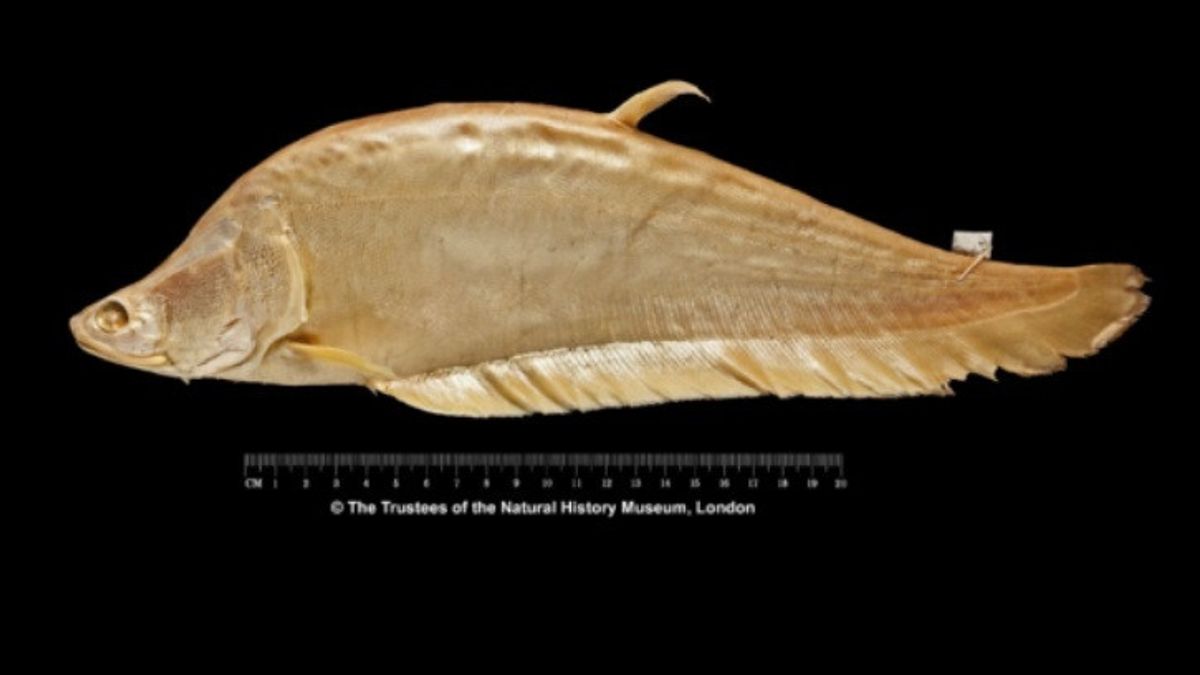JAKARTA The discovery of belida fish (Chitala lopis) in Java sparked the belief that Indonesia still has various types of new flora and fauna in it.
The National Research and Innovation Agency (BRIN) stated that the Belida Lopis fish was again found in Java Island in September 2023 after collaborating with researchers from the Food and Agriculture Organization (FAO), the Indonesian Green Harmoned Foundation, Jambi University, Charles Sturt University Australia, Vienna Museum, Austria, and Universite Montpellier, France.
The rediscovery of the belida fish comes from collections collected from November 2015 to September 2023 in 34 locations in Java, Sumatra, and Kalimantan.
The research team conducted a deoxyribonucleic Acid (DNA)barcoding sequence and morphological characterization to compare the data with the Barcode of Life Data (BOLD) and the species collection of Chitala lopis at the Natural History Museum, London.
The report on the results of the discovery was also released in a high-eputational journal (Q1) in Germany, namely the Journal of Endangered Species Research Volume 52, November 2023.
Quoting Kompas, researcher and Head of the BRIN Marine Resources and Land Resources Conservation Research Center, Arif Wibowo, said that this species of belida fish belongs to the Notopteridean family of the OrdoOsteoglossiformes. This ancient fish species has a fan-like fin shape. The evolution of C. lopis is thought to have occurred since 1,200 years ago.
The International Union for Conservation of Nature (IUCN) in early 2020 stated that the Chitala lopis had an extinction status or Extinct/EX. IUCN said, based on research conducted by Dr. Hoek Hee Ng (2020), C. lopis has not been found in the waters of the waters of Java Island since 172 years ago or since the specimens were collected by Pieter Bleeker in 1851.
However, the re-discovery of the lopis fish broke the information about the extinction. BRIN Associate Expert researcher Gema Wahyudedantoro, M.Si, when contacted by VOI emphasized that his party had never stated that the lopis belida had become extinct, even though it had been assessed by IUCN.
There are several reasons that Gema revealed why BRIN did not state that the belida C. lopis had an endangered status, including that further studies were needed regarding the distribution of broad lopis in Indonesia. However, Gema does not deny the decline in belida fish.
"Not extinct, but if it decreases, yes. This is because Chitala's habitat has been degraded and it is suspected that there are many results from anthropogenic activities that have a negative impact on the population of C. Explores," said Gema to VOI.
"In our discussion from BRIN, it is believed that the lopis belida is not extinct, and it is necessary to explore its location of spread. And now it is proven that the lopis belida still exists," he continued.
With the discovery of C.loppis belida fish again, Gema hopes that various other types of freshwater fish can be preserved through optimal monitoring. Gema said, Indonesia currently has 1,290 types of freshwater fish and several types are threatened with extinction due to several factors.
"What is clear is that our homework is together, especially policy makers and related agencies by including the community to be able to conserve, especially the lopis, and Indonesian native fish that are threatened with extinction," explained Gema.
"Domestication and cultivation activities must continue to be improved, and what is no less important is the aspect of supervision, especially in its natural habitat, so that the types of Belida lopis can be monitored optimally and their sustainability is maintained," said Gema again.
Before the discovery of the Belida lopis fish on the island of Java, the Indonesian Institute of Sciences (LIPI, now BRIN) managed to find a new bird species on Rote Island, East Nusa Tenggara in 2017 by LIPI researcher Dr. Dewi M. Prawiradilaga.
The endemic bird was later officially named Myzomela irianawidodoe, according to the name of the First Lady. The name was given as a form of appreciation to the First Lady who really pays attention to bird life, her dedication can be used as an example and an example in saving the environment in Indonesia.
After that, the researchers also LIPI found the Rote leaf-Wrabler (Phylloscopus rotensis) which is still a family with a fishing bird. From the analysis carried out, researchers can find out that the Rote Leaf-Warbler bird is a new type of bird and can only live on Rote Island.
The discovery of a new type of bird in less than 12 months is something special, because at least every year 5 to 10 new birds are found worldwide.
According to Gema, the discovery of various new types of fauna in Indonesia is proof that Indonesia has a high rich type of flora and fauna. In the future, it is also possible that various new types of fauna will be rediscovered in Indonesian territory.
SEE ALSO:
"The richness of Indonesian flora and fauna is very high, and BRIN explores all over the archipelago every year, and it is recorded that almost every year it is found that it is a new type and a new record," said Gema.
"So it is reasonable to suspect that there are still many regions in Indonesia that hold new types to be exposed immediately and of course they are preserved," said Gema emphasized.
The English, Chinese, Japanese, Arabic, and French versions are automatically generated by the AI. So there may still be inaccuracies in translating, please always see Indonesian as our main language. (system supported by DigitalSiber.id)














